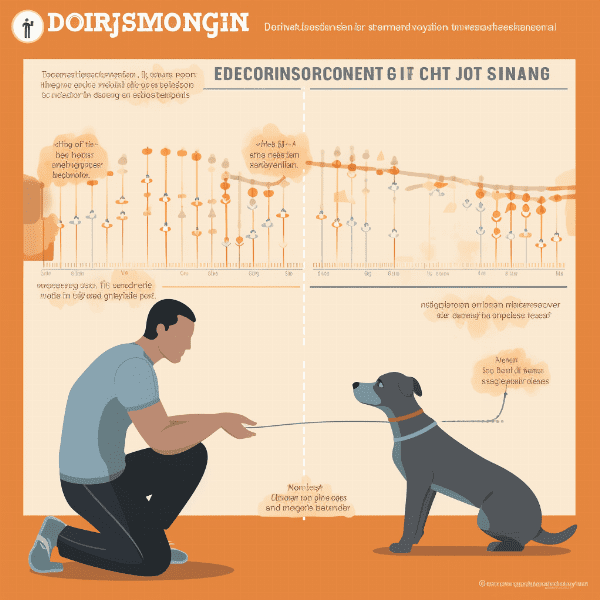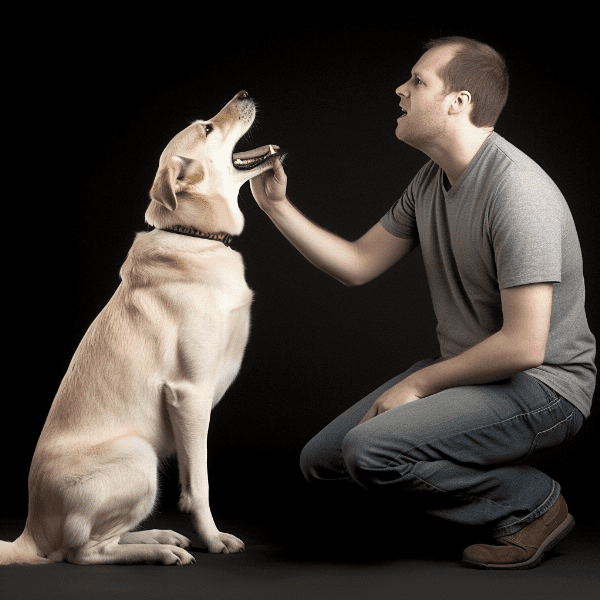Table of Contents
- Understanding Why Dogs Bark at People
- Identifying Triggers for Barking
- Techniques for Managing Barking
- Positive Reinforcement Training
- Consistency in Training
- Exercise and Mental Stimulation
- Addressing Underlying Behavioral Issues
- Seeking Professional Help
- Preventing Barking through Socialization
- Maintaining a Calm and Safe Environment
Understanding Why Dogs Bark at People
Dogs are known for barking; it is a natural behavior that serves many purposes. They bark to communicate, express emotions, alert others to potential danger, and even to seek attention. However, when dogs bark excessively at people, it can be problematic for both the dog and their owners.
Importance of Identifying the Reason for Barking
Identifying the underlying reason why a dog barks at people is crucial in addressing the behavior. Dogs can bark for various reasons, including fear, anxiety, territorial behavior, or lack of socialization. It is important to understand that barking is a form of communication for dogs, and it is up to the owner to interpret the message their dog is trying to convey.
Fear and Anxiety
One common reason why dogs bark at people is due to fear or anxiety. They may perceive people as a threat, leading them to bark as a way of warning or self-defense. Dogs that have had negative experiences with people, such as abuse or mistreatment, may also develop a fear or mistrust towards them, leading to excessive barking.
Territorial Behavior
Dogs may also bark excessively at people as a way of protecting their territory. They may perceive people as a threat to their home or family, leading them to bark as a way of warning or intimidation. This behavior is more common in certain breeds that are bred for guarding or protection.
.

Identifying Triggers for Barking
Identifying the triggers that cause a dog to bark at people is an essential step in addressing the behavior. Once the triggers have been identified, owners can develop strategies to manage and prevent the behavior from occurring.
Body Language and Vocalizations
One way to identify triggers for barking is to observe a dog’s body language and vocalizations. Dogs that are barking at people may exhibit signs of fear or aggression, such as growling, snarling, or showing their teeth. They may also have their ears pinned back or tail tucked between their legs. Understanding these cues can help owners determine what triggers their dog to bark.
Environmental Triggers
Environmental triggers can also cause dogs to bark excessively at people. For example, dogs may bark at people walking by their home, cyclists, or other dogs. Identifying the specific environmental triggers that cause the behavior can help owners develop strategies to manage the behavior. For example, if a dog barks at people walking by their home, owners can use curtains or blinds to block their dog’s view.
Previous Negative Experiences
Dogs that have had negative experiences with people in the past may also develop barking behavior. For example, a dog that has been mistreated or abused may develop a fear or mistrust towards people, leading them to bark excessively. Identifying past negative experiences can help owners understand their dog’s behavior and develop strategies to manage the behavior.
Lack of Socialization
Lack of socialization can also cause dogs to bark excessively at people. Dogs that have not been exposed to different people and situations during their critical socialization period may develop a fear or mistrust towards people, leading them to bark as a way of warning or self-defense.
In conclusion, identifying the triggers that cause a dog to bark at people is crucial in addressing the behavior. By understanding a dog’s body language, identifying environmental triggers, and recognizing past negative experiences, owners can develop strategies to manage the behavior effectively. With consistency and positive reinforcement training, dogs can learn to overcome excessive barking and lead happier lives.

Techniques for Managing Barking
There are several techniques that owners can use to manage their dog’s barking behavior. Each technique requires consistency and positive reinforcement training to be effective.
Distraction
Another technique for managing barking is distraction. This technique involves redirecting a dog’s attention from the trigger that causes them to bark. For example, if a dog barks at people walking by their home, owners can redirect their dog’s attention by giving them a toy or engaging them in play. This technique can help dogs learn to focus their attention on something positive and reduce their barking behavior.
Teach the “Quiet” Command
Teaching the “quiet” command is another technique for managing barking. This technique involves teaching a dog to stop barking on command. When a dog barks, owners can use a verbal cue, such as “quiet” or “enough,” and reward their dog when they stop barking. Over time, dogs can learn to associate the verbal cue with stopping their barking behavior.
Exercise and Mental Stimulation
Regular exercise and mental stimulation can also help manage barking behavior. Dogs that are physically and mentally stimulated are less likely to engage in excessive barking behavior. Owners can provide their dogs with plenty of exercise, such as walks or playtime, and mental stimulation, such as puzzle toys or training sessions.
.

Positive Reinforcement Training
Positive reinforcement training is a technique that focuses on rewarding a dog for good behavior rather than punishing them for bad behavior. This technique is effective in managing barking behavior and has several advantages over punishment-based training techniques.
Advantages of Positive Reinforcement Training
Positive reinforcement training has several advantages over punishment-based training techniques. First, it creates a positive relationship between the owner and the dog. When owners use positive reinforcement training, they build trust and respect with their dog, which can lead to better behavior.
Second, positive reinforcement training is more effective in the long run. When dogs are punished for bad behavior, they may become fearful or aggressive, which can lead to more behavior problems. In contrast, positive reinforcement training teaches dogs to behave well in a positive and rewarding environment.
Using Positive Reinforcement Training to Manage Barking
Positive reinforcement training can also be used to teach dogs the “quiet” command. When a dog stops barking on command, owners can use verbal praise, treats, or toys to reinforce the behavior. Over time, dogs learn to associate stopping barking with positive experiences and are more likely to respond to the command in the future.
In conclusion, positive reinforcement training is an effective technique for managing barking behavior. By rewarding good behavior, building a positive relationship with their dog, and creating a positive and rewarding environment, owners can help their dogs overcome excessive barking and improve their quality of life.

Consistency in Training
Importance of Consistency
Consistency is essential in dog training because it helps dogs understand what is expected of them. When owners are consistent in their training, dogs learn to associate specific behaviors with specific rewards or consequences. For example, if a dog is rewarded with treats every time they stop barking when told to do so, they will learn to associate stopping barking with positive experiences.
Inconsistent training can confuse dogs and lead to behavior problems. For example, if a dog is rewarded for stopping barking one day but scolded for the same behavior the next day, they may become unsure of what behavior is expected of them.
Consistency in Consequences
Owners must also be consistent in the consequences they give their dogs for bad behavior. For example, if a dog is scolded for barking excessively, they should receive the same consequence every time they engage in the behavior. This consistency helps dogs learn to associate specific behaviors with specific consequences.
Avoiding Mixed Messages
To avoid mixed messages, owners must be consistent in their training techniques. They should use the same verbal cues and body language every time they want their dog to stop barking. They should also be consistent in their use of rewards and consequences.
Persistence and Patience
Consistency in training requires persistence and patience. Owners must be persistent in their training techniques and patient with their dog’s progress. It takes time for dogs to learn new behaviors and habits, and consistency is the key to success.
In conclusion, consistency is a crucial element in managing barking behavior in dogs. By being consistent in their training techniques, rewards, and consequences, owners can help their dogs learn to behave well and improve their quality of life. With patience, persistence, and consistency, dogs can overcome excessive barking and lead happier lives.

Exercise and Mental Stimulation
Regular exercise and mental stimulation are crucial elements in managing barking behavior in dogs. Providing dogs with ample opportunities to exercise and engage in mentally stimulating activities can help reduce excessive barking behavior.
The Importance of Exercise
Exercise is an essential element in managing barking behavior in dogs. Regular exercise helps dogs release pent-up energy and reduce anxiety or stress, which can lead to excessive barking behavior. Owners should provide their dogs with ample opportunities to exercise, such as walks, runs, or playtime.
Mental Stimulation
Mental stimulation is another critical element in managing barking behavior in dogs. Providing dogs with mentally stimulating activities can help reduce boredom and anxiety, which can lead to excessive barking behavior. Owners can provide their dogs with puzzle toys, training sessions, or other mentally stimulating activities to keep their minds engaged.
Combination of Exercise and Mental Stimulation
A combination of exercise and mental stimulation is the most effective way to manage barking behavior in dogs. Owners should provide their dogs with opportunities to exercise and engage in mentally stimulating activities daily. For example, owners can take their dogs for a walk and engage them in a training session afterward.
Exercise and Mental Stimulation for Specific Breeds
Certain breeds require more exercise and mental stimulation than others. For example, working breeds, such as Border Collies or Australian Shepherds, require ample opportunities to exercise and engage in mentally stimulating activities. Owners of these breeds should provide their dogs with a variety of activities to keep them engaged and reduce excessive barking behavior.
The Importance of Consistency
Consistency is also crucial in providing dogs with ample exercise and mental stimulation. Owners should be consistent in providing their dogs with exercise and mentally stimulating activities. A consistent routine can help reduce anxiety and stress, which can lead to excessive barking behavior.
In conclusion, regular exercise and mental stimulation are crucial elements in managing barking behavior in dogs. Owners should provide their dogs with ample opportunities to exercise and engage in mentally stimulating activities daily. A combination of exercise and mental stimulation is the most effective way to manage barking behavior in dogs. With consistency and persistence, dogs can learn to overcome excessive barking and lead happier lives.

Addressing Underlying Behavioral Issues
Underlying behavioral issues can contribute to excessive barking behavior in dogs. Addressing these issues is crucial in managing barking behavior effectively.
Identifying Underlying Behavioral Issues
Identifying underlying behavioral issues is the first step in addressing excessive barking behavior. Owners should observe their dog’s behavior to identify any patterns or triggers that contribute to the behavior. For example, if a dog barks excessively when left alone, they may be experiencing separation anxiety.
Consistency in Training
Consistency in training is also crucial in addressing underlying behavioral issues. Owners should be consistent in their training techniques, rewards, and consequences to help their dogs learn new behaviors and habits.
Positive Reinforcement Training
Positive reinforcement training can be effective in addressing underlying behavioral issues that contribute to excessive barking behavior. By rewarding good behavior, owners can help their dogs learn new behaviors and reduce anxiety or stress that may contribute to excessive barking.
Medication
.

Seeking Professional Help
In some cases, managing barking behavior in dogs may require professional help. Trained professionals, such as dog behaviorists or trainers, can provide owners with additional strategies and techniques to manage their dog’s behavior.
When to Seek Professional Help
Owners should consider seeking professional help if their dog’s barking behavior is excessive or if they are unable to manage the behavior on their own. Professional help may also be necessary if the dog has underlying behavioral issues that contribute to the barking behavior.
Benefits of Seeking Professional Help
Seeking professional help can provide owners with additional strategies and techniques to manage their dog’s barking behavior effectively. Trained professionals can also identify underlying behavioral issues that may be contributing to the barking behavior and develop strategies to address those issues.
Working with a Dog Behaviorist
Dog behaviorists are trained professionals who specialize in managing behavior problems in dogs. They can provide owners with a comprehensive assessment of their dog’s behavior and develop a personalized plan to manage the behavior.
Working with a Dog Trainer
Dog trainers can also provide owners with strategies and techniques to manage barking behavior in dogs. They can teach owners how to use positive reinforcement training to address the behavior and provide guidance on managing underlying behavioral issues.
Medication
In some cases, medication may be necessary to manage barking behavior in dogs. Trained professionals, such as veterinarians or dog behaviorists, can prescribe medication to help manage anxiety, fear, or other underlying behavioral issues that may contribute to excessive barking behavior.
Patience and Persistence
Seeking professional help requires patience and persistence. It takes time for dogs to learn new behaviors and habits, and owners should be patient with their dog’s progress. Consistency in training and following the advice of trained professionals can help owners manage their dog’s barking behavior effectively.
In conclusion, seeking professional help can be beneficial in managing barking behavior in dogs. Trained professionals can provide owners with additional strategies and techniques to manage the behavior effectively and identify underlying behavioral issues that may be contributing to the behavior. With patience and persistence, owners can help their dogs overcome excessive barking and lead happier lives.

Preventing Barking through Socialization
Socialization is an essential element in preventing excessive barking behavior in dogs. Proper socialization can help dogs feel more comfortable and confident in different environments and reduce anxiety or stress that may contribute to excessive barking behavior.
Proper Socialization Techniques
Proper socialization techniques involve exposing dogs to new experiences gradually and positively. Owners should start with low-stress environments and gradually expose their dogs to more challenging situations. They should also use positive reinforcement training to reward good behavior and help their dogs feel more comfortable and confident in new environments.
Continued Socialization
Socialization should be a lifelong process for dogs. Owners should continue to expose their dogs to new experiences, people, and environments throughout their lives. This continued exposure can help dogs feel more comfortable and confident in different situations and reduce anxiety or stress that may contribute to excessive barking behavior.
Training and Socialization
Training and socialization go hand in hand in preventing excessive barking behavior in dogs. Owners should use positive reinforcement training techniques to teach their dogs appropriate behavior in different situations. They should also expose their dogs to different environments, people, and animals to help them feel more comfortable and confident.
Benefits of Socialization
Proper socialization can have numerous benefits for dogs beyond preventing excessive barking behavior. It can help dogs become more well-adjusted, friendly, and confident. Proper socialization can also reduce anxiety, stress, and aggression in dogs.

Maintaining a Calm and Safe Environment
Maintaining a calm and safe environment is essential in managing barking behavior in dogs. A calm and safe environment can help reduce anxiety or stress that may contribute to excessive barking behavior.
Reducing Environmental Triggers
Owners should identify and reduce environmental triggers that may contribute to excessive barking behavior in their dogs. For example, if a dog barks excessively at people walking by outside, owners can close blinds or curtains to reduce visual triggers. If a dog barks excessively at noises, owners can use white noise machines or soundproofing to reduce auditory triggers.
Calm and Positive Energy
Owners should maintain a calm and positive energy around their dogs. Dogs can pick up on their owner’s energy and react accordingly. Maintaining a calm and positive energy can help reduce anxiety or stress in dogs and prevent excessive barking behavior.
Safe and Comfortable Space
Providing dogs with a safe and comfortable space can also help reduce anxiety or stress that may contribute to excessive barking behavior. Owners should provide their dogs with a designated space, such as a crate or bed, where they feel safe and comfortable.
Avoiding Punishment
Punishing dogs for excessive barking behavior can be counterproductive and lead to further anxiety or stress. Instead of punishment, owners should use positive reinforcement training techniques to teach their dogs appropriate behavior in different situations.
Consistency in Routine
Consistency in routine is also crucial in maintaining a calm and safe environment for dogs. Dogs thrive on routine, and a consistent routine can help reduce anxiety or stress that may contribute to excessive barking behavior.
In conclusion, maintaining a calm and safe environment is essential in managing barking behavior in dogs. By reducing environmental triggers, maintaining a calm and positive energy, providing a safe and comfortable space, avoiding punishment, and being consistent in routine, owners can help their dogs feel more comfortable and confident in different situations and reduce anxiety or stress that may contribute to excessive barking behavior. With patience, persistence, and proper environment management, dogs can overcome excessive barking behavior and lead happier lives.




